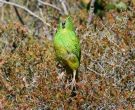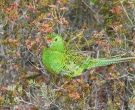Content
|
|---|
|
Video “Western Ground Parrot”
|
Description:
30 cms. length between 105-110 g. of weight.
The Western Ground Parrot (Pezoporus flaviventris) It has mottled green back, underparts green and yellow, forecrown red. Tail long, with green stripes, Yellow and black poorly defined.
taxonomy:
A research team, directed by Stephen Murphy, studied taxonomy (discipline in charge of classifying living things) of the Eastern Ground Parrot (Pezoporus wallicus), an endemic species (exclusive geographic region) of fragmented coasts of southwest and southeast Australia. The researchers studied DNA from museum specimens from 160 years, and they concluded that the western population should be classified as a new species: Pezoporus flaviventris.
Habitat:
The Western Ground Parrot It is a bird that lives in soil and living in low heathland, dry or swampy near the coast. They are usually seen in habitat that has remained unburned for long periods of time. Mainly fly at dawn or dusk and feeds mainly on small seeds.
Reproduction:
It is one of the few parrots in the world that does not nest in a hole or cavity. Little else is known about the reproductive biology of the Western Ground Parrot
Food:
The Western Ground Parrot usually it feeds alone or with another parakeet. Seeds of various plants, especially of Sedge, for example, Mesomaelaena stygia ssp. stygia. Flower buds and flowers base, for example, the beaufortias, the dryandras and grevilleas, They are also important parts of the diet. It has been observed Western Ground Parrot semisuculentas feeding on leaves Daviesia pachyphylla. The diet is varied and uses the great diversity of habitat.
Distribution:
Historically, This species was found along the south west coast of Australia from Perth north to Geraldton and along the south coast east to Israelite Bay. But, It seems to have disappeared off the west coast of Western Australia in 1900.
Today only two locations are known from the extreme southwest of Western Australia: Fitzgerald River National Park and Cabo Arid National Park / Natural Reserve Nuytsland
Conservation:
• It is classified by the Australian government as a species in danger of extinction.
• Population trend: Decreasing.
• Population size : 100-110 individuals.
During an investigation (1), scientists found that the population of this new species had diminished quickly in the last 20 years, They are leaving only around 110 birds surviving in the wild, most of them in an Australian national park, so it is considered one of the rarest species in the world, so that the entry introduced predators (cats) National Park, could lead to the extinction of the species in a short time, so the need to implement is suggested Urgent conservation program for this new species described.
(1) – “Tip(‘9. S. A. Murphy, S. A., L. Joseph, A. H. Burbidge y J. Austin. “A Cryptic and Critically Endangered Species Revealed by Mitochondrial DNA Analyses: the Western Ground Parrot”. Conservation Genetics, 12, (2010): 595-600.’
Alternative names:
– Ground Parrot (Western), Western Ground Parrot (English).
– Kyloring (Aboriginal).
– Perruche à ventre doré, Perruche à ventre dorée, Perruche terrestre (de l’Ouest), Perruche terrestre (flaviventris) (French).
– Westlicher Erdsittich (German).
– Periquito Terrestre Occidental (Portuguese).
– Perico Terrestre Occidental (español).
scientific classification:

– Order: Psittaciformes
– Family: Psittaculidae
– Gender: Pezoporus
– Scientific name: Pezoporus flaviventris
– Subpoena: North, 1911
– Protonimo: Pezoporus flaviventris
Images “Western Ground Parrot”:
Sources:
• Avibase
• Parrots of the World – Forshaw Joseph M
• Parrots A Guide to the Parrots of the World – Tony Juniper & Mike Parr
• Science and Development Magazine
• Department of the Environment (2018). Pezoporus flaviventris in Species Profile and Threats Database, Department of the Environment, Canberra. Available from: http://www.environment.gov.au/sprat.
Photos:
(1) – Feeding Western Ground Parrot….. the only photo’s of this bird in the wild was taken in 2005 the day before my birthday, what a gift that was. This is from my field season the next year. No nest has been found since 1913. by Brent Barrett – Flickr
(2) – Western Ground Parrot (Pezoporus flaviventris) by Brent Barrett from Dunedin, New Zealand [CC BY-SA 2.0 or CC BY-SA 2.0], via Wikimedia Commons
(3) – A Western Ground Parrot in Australia by Brent Barrett from Dunedin, New Zealand [CC BY-SA 2.0], via Wikimedia Commons
(4) – Stand and sing Western Ground Parrot (Pezoporus flaviventris) by Brent Barrett from Dunedin, New Zealand [CC BY-SA 2.0], via Wikimedia Commons
(5) – This is officially one of the rarest images in exhistence Pezoporus wallicus flaviventris by Brent Barrett – Flickr





